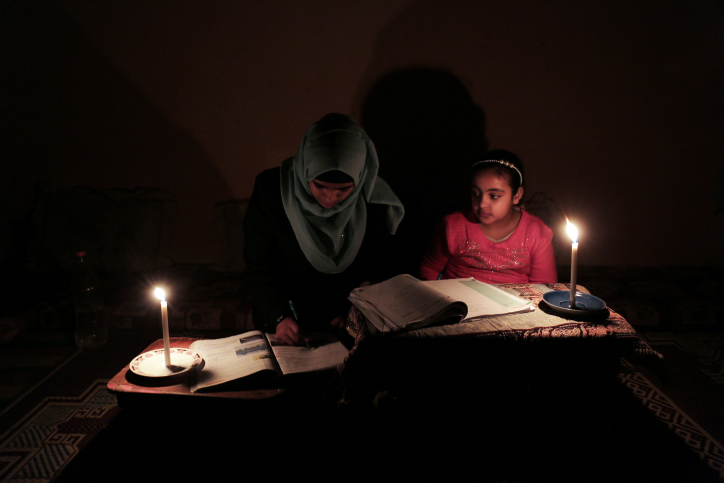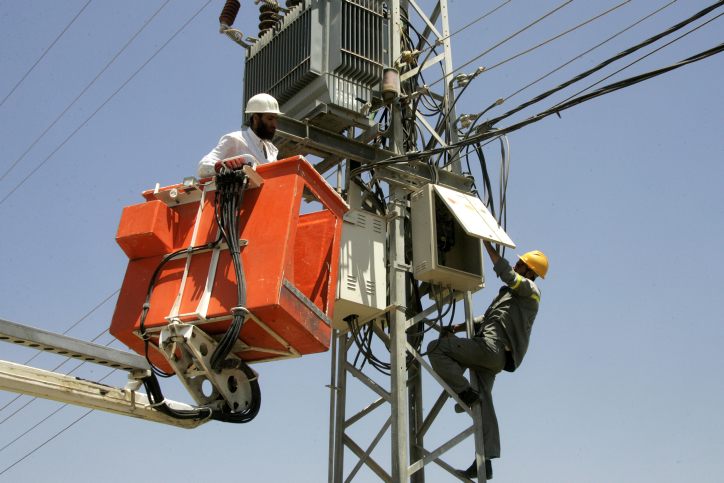
Two years ago, when the lights went out along Gaza’s shore, the Hindi family lit up some candles in their home. What ensued was a tragedy: their house burned down, and they lost three of their children in the fire. Unfortunately, these incidents are not uncommon in Gaza.
The Gaza Strip, home to 2 million Palestinians, has been suffering from a severe electricity crisis for years, and Gazans have grown accustomed to an average of four hours of electricity a day. A new initiative aims to harness the energy of the sun to overcome this crisis, and reduce Gaza’s reliance on Israel for electricity.
Khalid Nasman, 45, an electrical engineer from Gaza City, took it upon himself to install solar grids on rooftops in his neighborhood, where 15 houses and businesses agreed to raise $37,000 to collectively purchase a set of solar panels. “The cost of solar panels is relatively low compared to conventional fossil energy, such as natural gas and diesel fuels, which fluctuate in price. Their maintenance has also become economically and practically useless, given the frequent closures of the crossings,” said Nasman.
The cells are a source of hope, he added – they can provide electricity for an uninterrupted 24 hours, and compensate for the shortage the neighborhood incurs during outages. Solar energy has allowed residents to operate various household appliances, such as fans, which have been especially helpful during summer heatwaves.
According to Nasman, renewable energy projects in the Gaza Strip are steadily expanding. International organizations are increasingly sponsoring development projects that supply hundreds of homes, health centers, schools, water desalination plants and sewage plants with solar cells. Several lending institutions are providing green loans, designed to encourage people to make energy-saving improvements to their homes and businesses.

Gaza’s chronic electricity deficit intensified after Hamas took over the strip in 2006. That summer, when Hamas militants captured Israeli soldier Gilad Schalit (he was released in a 2011 prisoner swap), Israel bombed the only power plant there, which used to supply 43 percent of the electricity in Gaza. Now, the strip needs an estimated 500 megawatts a day but only gets about a third of that, from three different sources. The power station in Gaza produces about 23 megawatts, 120 megawatts are imported from Israel, and the Palestinian Authority purchases around 30 more megawatts from Egypt.
Earlier this year, the United Nations Office for the Coordination of Humanitarian Affairs (OCHA) in the occupied Palestinian territories warned that the Gaza Strip is on the “verge of disaster” due to electricity and fuel shortages. In June, Gaza’s only power company announced a further reduction in the enclave’s electricity supply, after its sole power station stopped functioning.
“Renewable energy is clean and does not generate any harmful emissions. Most importantly, it does not allow the Israelis to control it, so it can be relied upon to generate electricity for homes and various facilities and schools in Gaza and the West Bank, especially in light of its low operating costs relative to conventional energy,” said Ayman Ismail, the director of the Palestinian Energy and Environment Research Center (PEC) in Ramallah.
In 2017 alone, the Palestinian Authority connected 82 schools to solar panel grids, Ismail added. The PA’s Palestinian Investment Fund plans to build solar farms on the rooftops of 500 public schools, and sell the surplus to Palestinian electric distribution companies as an investment. The Authority also intends to supply 10 percent of homes in the West Bank with renewable energy by 2030, according to Ismail.
Engineer Fadi Bkirat, one of the founders of the Palestinian Federation of Renewable Energy Industries (FREI), said the shortage of traditional sources of electricity in the West Bank and the Gaza Strip has provided motivation to explore alternative sources for electricity generation, including solar energy. “This also reduces the electricity bill that the Palestine Electric Company pays Israel, which could amount to billions of dollars a year,” he added.

To attract investors, renewable energy equipment and appliances are 100 percent exempt from custom duties and value-added tax in Palestine. But, due to reality of life and commerce under military occupation, investors are hesitant to back solar energy initiatives, said Bkirat.
While renewable energy affords Palestinians some degree of independence, they still rely on Israel to get ahold of the necessary equipment. Solar cells and renewable energy appliances are imported, and enter Gaza through the Israeli-controlled Kerem Shalom crossing, the only passage point for the import and export of commercial goods.
Israel withdrew its troops and settlements from Gaza in 2005, but the IDF soon after imposed a blockade on the coastal enclave. The Israeli army now controls the strip’s land and maritime borders, determines who and what may enter and exit, and can arbitrarily decide if and when to open the crossing. As such, Israeli policy usually dictates how long a renewable energy project could take to fully implement, and whether the devices make it to the occupied territories at all.
According to economic expert Moeen Rajab, investments in renewable electricity could create hundreds of more jobs in the Gaza Strip and the West Bank, which may help reduce surging unemployment rates in Palestinian society. These investments could contribute to Palestine’s GDP, he added: energy is a key driver of economic growth in any country, and if adequately invested in as a significant part of production processes, “it could provide long-term investment opportunities in the energy sector.”
is an independent Palestinian journalist from Gaza City who covers humanitarian and social issues. He holds a BA in journalism and media from Al-Aqsa University.
